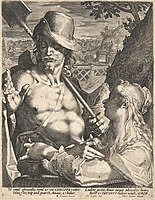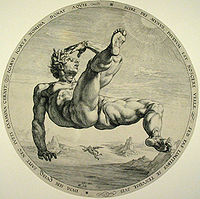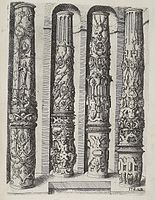Northern Mannerism
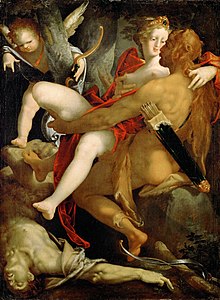
Northern Mannerism is the form of Mannerism found in the visual arts north of the Alps in the 16th and early 17th centuries.[1] Styles largely derived from Italian Mannerism were found in the Netherlands and elsewhere from around the mid-century, especially Mannerist ornament in architecture; this article concentrates on those times and places where Northern Mannerism generated its most original and distinctive work.
The three main centres of the style were in France, especially in the period 1530–1550, in Prague from 1576, and in the Netherlands from the 1580s—the first two phases very much led by royal patronage. In the last 15 years of the century, the style, by then becoming outdated in Italy, was widespread across northern Europe, spread in large part through prints. In painting, it tended to recede rapidly in the new century, under the new influence of Caravaggio and the early Baroque, but in architecture and the decorative arts, its influence was more sustained.[2]
Background
The sophisticated art of Italian Mannerism begins during the High Renaissance of the 1520s as a development of, a reaction against, and an attempt to excel, the serenely balanced triumphs of that style. As art historian Henri Zerner explains: "The concept of Mannerism—so important to modern criticism and notably to the renewed taste for Fontainebleau art—designates a style in opposition to the classicism of the Italian Renaissance embodied above all by Andrea del Sarto in Florence and Raphael in Rome".[3]
The High Renaissance was a purely Italian phenomenon, and Italian Mannerism required both artists and an audience highly trained in the preceding Renaissance styles, whose conventions were often flouted in a knowing fashion. In Northern Europe, however, such artists, and such an audience, could hardly be found. The prevailing style remained Gothic, and different syntheses of this and Italian styles were made in the first decades of the 16th century by more internationally aware artists such as Albrecht Dürer, Hans Burgkmair and others in Germany, and the misleadingly named school of Antwerp Mannerism, in fact unrelated to, and preceding, Italian Mannerism.[4] Romanism was more thoroughly influenced by Italian art of the High Renaissance, and aspects of Mannerism, and many of its leading exponents had travelled to Italy. Netherlandish painting had been generally the most advanced in northern Europe since before 1400, and the best Netherlandish artists were better able than those of other regions to keep up with Italian developments, though lagging at a distance.
For each succeeding generations of artists, the problem became more acute, as much Northern work continued to gradually assimilate aspects of Renaissance style, while the most advanced Italian art had spiralled into an atmosphere of self-conscious sophistication and complexity that must have seemed a world apart to Northern patrons and artists, but enjoyed a reputation and prestige that could not be ignored.[5]
France

France received a direct injection of Italian style in the form of the first School of Fontainebleau, where from 1530 several Florentine artists of quality were hired to decorate the royal Palace of Fontainebleau, with some French assistants being taken on. The most notable imports were Rosso Fiorentino (Giovanni Battista di Jacopo di Gaspare, 1494–1540), Francesco Primaticcio (c. 1505–1570), Niccolò dell'Abbate (c. 1509–1571), all of whom remained in France until their deaths. This conjunction succeeded in generating a native French style with strong Mannerist elements that was then able to develop largely on its own. Jean Cousin the Elder, for example, produced paintings, such as Eva Prima Pandora and Charity, that, with their sinuous, elongated nudes, drew palpably upon the artistic principles of the Fontainebleau school.[6]
Cousin's son Jean the Younger, most of whose works have not survived, and Antoine Caron both followed in this tradition, producing an agitated version of the Mannerist aesthetic in the context of the French Wars of Religion. The iconography of figurative works was mostly mythological, with a strong emphasis on Diana, goddess of the hunting that was the original function of Fontainebleau, and namesake of Diane de Poitiers, mistress and muse of Henry II, and keen huntress herself. Her slim, long-legged and athletic figure "became fixed in the erotic imaginary".[7]
Other parts of Northern Europe did not have the advantage of such intense contact with Italian artists, but the Mannerist style made its presence felt through prints and illustrated books, the purchases of Italian works by rulers and others,[8] artists' travels to Italy, and the example of individual Italian artists working in the North.

Much of the most important work at Fontainebleau was in the form of stucco reliefs, often executed by French artists to drawings by the Italians (and then reproduced in prints), and the Fontainebleau style affected French sculpture more strongly than French painting. The huge stucco frames which dominate their inset paintings with bold high-relief strapwork, swags of fruit, and generous staffage of naked nymph-like figures, were very influential on the vocabulary of Mannerist ornament all over Europe, spread by ornament books and prints by Androuet du Cerceau and others—Rosso seems to have been the originator of the style.
A number of areas in the decorative arts joined in the style, especially where there were customers from the court. High-style walnut furniture made in metropolitan centers like Paris and Dijon, employed strapwork framing and sculptural supports in dressoirs and buffets. The mysterious and sophisticated Saint-Porchaire ware, of which only about sixty pieces survive, brought a similar aesthetic into pottery, and much of it carries royal cyphers. This was followed by the "rustic" pottery of Bernard Palissy, with vessels covered in elaborately modelled relief animals and plants. Painted Limoges enamel adopted the style with enthusiasm around 1540, and many workshops produced highly detailed painting until about the 1580s.
Apart from the Palace of Fontainebleau itself, other important buildings decorated in the style were the
-
Monument containing the heart of Henry II of France, Germain Pilon
-
Shield of Henry II of France, steel damascened in silver and gold, design attributed toEtienne Delaune
-
Design for a Vessel Presented to Henry II, Jean Cousin the Elder, 1549
-
Detail of dish in Limoges enamel, mid-16th century, attributed to Jean de Court
-
Saint-Porchaire ware, Triangular salt, 1540s?, 6 7/8 in. (17.5 cm) high, with a (?) satyr, and (?) Venus at right.
Prague under Rudolf II

Maximilian II, Holy Roman Emperor (reigned 1564–1576), who made his base in Vienna, had humanist and artistic tastes, and patronised a number of artists, mostly famously Giambologna and Giuseppe Arcimboldo, whose fantasy portraits made up of objects were slightly more serious in the world of late-Renaissance philosophy than they seem now. At the end of his reign he devised a project for a new palace and just before he died the young Flemish painter Bartholomeus Spranger had been summoned from Rome, where he had made a successful career. Maximilian's son, Rudolf II, Holy Roman Emperor was to prove an even better patron than his father would have been, and Spranger never left his service. The court soon transferred to Prague, safer from the regular Turkish invasions, and during his reign of 1576–1612 Rudolf was to become an obsessive collector of old and new art, his artists mixing with the astronomers, clockmakers, botanists, and "wizards, alchemists and kabbalists" whom Rudolf also gathered around him.[9]

Rudolf's artistic preferences were for mythological scenes with nudes as well as allegorical propaganda pieces which extolled the virtues of himself as ruler. A work combining the elements of eroticism and propaganda is Minerva triumphs over Ignorance (Kunsthistorisches Museum), which shows Minverva (the Roman goddess of war, wisdom, arts and trade) with exposed breasts and a helmet treading down Ignorance, symbolised by a man with the ears of an ass. Bellona, another Roman goddess of war, and the nine Muses surround Minerva. The propaganda message is that the empire is safe with Rudolf at the helm so that the arts and trade can flourish.[11]: 68–69 The Flemish sculptor Hans Mont also worked for Rudolf and designed the triumphal arch for Rudolf II's formal entry into Vienna in 1576.[12]
Works from Rudolf's Prague were highly finished and refined, with most paintings being relatively small. The elongation of figures and strikingly complex poses of the first wave of Italian Mannerism were continued, and the elegant distance of Bronzino's figures was mediated through the works of the absent Giambologna, who represented the ideal of the style.
Rudolf was not very interested in religion, and "in the Prague of Rudolf II, an explosion of mythological imagery was produced that had not been seen since Fontainebleau".[14] Goddesses were usually naked, or nearly so, and a more overt atmosphere of eroticism prevails than is found in most Renaissance mythological works, evidently reflecting Rudolf's "special interests".[15]
The dominating figure was
Influence of Prague elsewhere
-
, 1601, 21 x 16 cm on copper.
-
Hans von Aachen, Allegory of Peace and the Arts, 1602.[19]
-
Haarlem – Karel van Mander, Garden of Love, 1602
-
Haarlem – Roelant Savery, Garden of Eden, a typical subject, 1622. Rudolf also had large menageries, including a dodo, seen in many paintings.
Netherlands Mannerism

Whereas the artists of both Fontainebleau and Prague were mostly provided with a home so congenial in both intellectual and physical terms that they stayed to the end of their lives, for artists of the last Netherlandish phase of the movement Mannerism was very often a phase through which they passed before moving on to a style influenced by Caravaggio.
For

Partly because most of his Netherlandish followers had only seen Spranger's work through prints and his mostly very free drawings, his more painterly handling was not adopted, and they retained the tighter and more realistic technique in which they had been trained. Many Dutch mannerist painters could switch styles depending on subject or commission, and continued to produce portraits and genre scenes in styles based on local traditions at the same time they were working on highly Mannerist paintings. After his return from Italy, Goltzius moved to a quieter proto-Baroque classicism, and his work in that style influenced many.
For painters in the Low Countries there was also the alternative of traditional Northern realist styles, which had continued to develop through Pieter Bruegel the Elder (d.1567) and other artists, and in the next century were to dominate the painting of the Dutch Golden Age. Despite his visit to Italy, Brughel certainly cannot be called a Mannerist, but just as his paintings were keenly collected by Rudolf, Mannerist artists, including Gillis van Coninxloo and Bruegel's son Jan, followed him in developing the landscape as a subject.
Landscape painting was recognised as a Netherlandish speciality in Italy, where several Northern landscapists were based, such as
Joris Hoefnagel, a court painter of Rudolf II, played an important role in the development of the still life as an independent genre, and in particular still lifes of flowers. An undated flower piece executed by Hoefnagel in the form of a miniature is the first known independent still life. Hoefnagel enlivened his flower pieces with insects and attention to detail typical of his nature studies. This can be seen in his 1589 Amoris Monumentum Matri Chariss(imae) (ex-Nicolaas Teeuwisse 2008).[26]
Karel van Mander is now remembered mainly as a writer on art rather than an artist. Though he endorsed the Italian
The Mannerist painters in the now permanently separated southern provinces of
In Flanders, though not in the United Provinces, the mostly temporary displays for
Poland–Lithuania
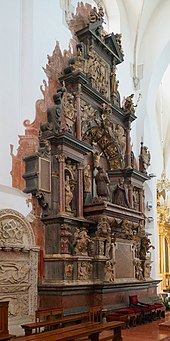
Mannerism was dominant in
Dissemination in prints and books

The importance of prints as a medium for disseminating Mannerist style has already been mentioned; Northern Mannerism "was a style that lent itself admirably to printmaking, and inspired the production of a succession of masterpieces of the printmaker's art".[37] Goltzius was already the most celebrated engraver in the Netherlands when the Mannerist virus struck, and despite the disruptions of war he and other Netherlandish printmakers were connected with the well-oiled machinery of distribution across Europe that had been built up over the preceding fifty years, originally centred on Antwerp.
The same had not been true for the printmaking at Fontainebleau, and the prints made there (unusually for the period, all in etching) were technically rather rough, produced in smaller numbers, and mainly influential in France. They were made in an intense period of activity approximately from 1542 to 1548.[38] Those made in Paris were engravings and of a higher quality; produced from about 1540 to about 1580, they had a wider distribution.[39]
Many of the Fontainebleau prints were apparently made directly from drawn designs for the decorations of the palace, and consisted largely or entirely of ornamental frames or cartouches, although such was the scale of Fontainebleau that these might contain several full-length figures. Variations on the elaborate framings, as if made of cut, pierced and rolled parchment, played out in decorative framing schemes, engraved title pages and carved and inlaid furniture into the seventeenth century.[40]
Printed Mannerist ornament, in a somewhat broader sense of the word, was a good deal easier to produce than the risky application of an extreme Mannerist style to large figure compositions, and had been spreading across Europe well in advance of painting in the form of frames to portrait prints, book frontispieces, so like the elaborate doorways and fireplaces of Mannerist architecture,[41] ornament books for artists and craftsmen, and emblem books. From these and works in their own medium, goldsmiths, frame and furniture makers, and workers in many other crafts developed the vocabulary of Mannerist ornament.
The pattern illustrations shown in Wendel Dietterlin's book Architectura of 1593–4, produced in the relative backwater of Strasbourg, were some of the most extreme application of the style to architectural ornament.[37] The Northern Mannerist style was especially influential in the prodigy houses built in England by Elizabethan courtiers.
-
Christ and Mary Magdalene in the garden. Sadeler engraving after Bartholomeus Spranger
-
Jan Saenredam, Venus and Cupid, after Hendrick Goltzius
-
Icarus by Goltzius
-
Composite order columns from Wendel Dietterlin's Architectura (1593–94).
In the decorative arts

The visual wit and sophistication of Mannerism in northern hands, which made it pre-eminently a
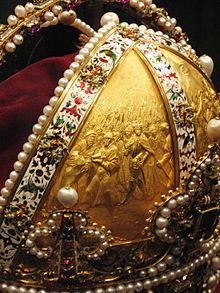
Though Mannerist sculptors produced life-size bronzes, the bulk of their output by unit was of editions of small bronzes, often reduced versions of the large compositions, which were intended to be appreciated by holding and turning in the hands, when the best "give an aesthetic stimulus of that involuntary kind that sometimes comes from listening to music".[46] Plaquettes, small low relief panels in bronze, often gilded, were used in various settings, as on Rudolph's crown.[47]
In France, Saint-Porchaire ware of Mannerist forms and decor was produced in limited quantities for a restricted fashion-conscious clientele from the 1520s to the 1540s, while the crowded, disconcertingly lifelike compositions of snakes and toads characterize the Mannerist painted earthenware platters of Bernard Palissy. Like the Jamnitzers on occasion,[50] Palissy made moulds from real small creatures and plants to apply to his creations.
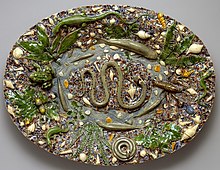
Northern Mannerism, politics and religion
Northern Europe in the 16th century, and especially those areas where Mannerism was at its strongest, was affected by massive upheavals including the
In the case of Rudolf's Prague and French art after the mid-century, secular and mythological Mannerist art seems to have been partly a deliberate attempt to produce an art that appealed across religious and political divides.
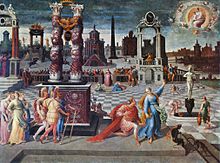
Certain Mannerist works seem to echo the violence of the time, but dressed in classical clothing.

Cornelis van Haarlem's Massacre of the Innocents (1590, Rijksmuseum), more Baroque than Mannerist, may involve his childhood memories of the killings (in fact only of the garrison) after the Siege of Haarlem in 1572–3, which he lived through. Brughel's completely un-mannerist version of the same subject was bought by Rudolf, who had someone turn many of the massacred children into geese, calves, cheeses, and other less disturbing spoils.[59] In general, Mannerist painting emphasizes peace and harmony, and less often chooses battle subjects than either the High Renaissance or the Baroque.
Another subject popularized by Brughel, Saint John Preaching in the Wilderness, was given Mannerist treatments by several artists, as a lush landscape subject. But for Dutch Protestants the subject recalled the years before and during their Revolt, when they were forced to congregate for services in the open countryside outside towns controlled by the Spanish.[54]
Other outcrops

Some (but not all) of the prodigy houses of Elizabethan architecture made use of ornament derived from the books of Wendel Dietterlin and Hans Vredeman de Vries within a distinctive overall style derived from many sources.
The portrait miniaturist Isaac Oliver shows tentative Late Mannerist influence,[60] which also appears in some immigrant portrait painters, such as William Scrots, but generally England was one of the countries least affected by the movement except in the area of ornament.
Though Northern Mannerism achieved a landscape style, portrait-painting remained without Northern equivalents of Bronzino or Parmigianino, unless the remarkable but somewhat naive Portraiture of Elizabeth I is considered as such.
One of the last flowerings of Northern Mannerism came in
Even later, the German-
Artists

French artists influenced by the first School of Fontainebleau:
- Jean Cousin the Elder (1500–c. 1590)
- Jean Goujon (c. 1510–after 1572) sculptor and architect
- Juste de Juste (c. 1505 – c. 1559) – sculptor and etcher
- Antoine Caron (1521–1599)
The continuing French tradition:
- Germain Pilon (c. 1537–1590), sculptor
- Androuet du Cerceau, family of architects; Jacques I introducing Mannerist ornament
- Jean Cousin the Younger (ca. 1522–1595), painter
- Toussaint Dubreuil (c. 1561–1602), second School of Fontainebleau:
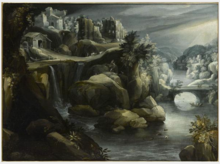
Working for Rudolf:
- Giambologna (1529–1608), Flemish sculptor based in Florence
- Adriaen de Vries (1556–1626), Dutch sculptor, pupil of Giambologna, who went to Prague
- Bartholomeus Spranger (1546–1611) – Flemish painter, Rudolf's main painter
- Hans von Aachen (1552–1615) – German, mythological subjects and portraits for Rudolf
- Joseph Heintz the Elder (1564–1609) – Swiss pupil of Hans von Aachen
- Paul van Vianen, Dutch silversmith and artist
- Aegidius Sadeler – mainly a printmaker
- Wenzel Jamnitzer (1507/8–1585), and his son Hans II and grandson Christof, German goldsmiths
- Joris Hoefnagel, especially for miniatures of natural history
- Roelant Savery, landscapes with animals and still-lifes
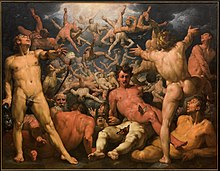
In the Netherlands:
- Herri met de Bles, (1510–1555/60), landscape artist, earlier than the others
- Karel van Mander – now best known as a biographer of Netherlandish artists
- Hendrik Goltzius(1558–1617) – the leading engraver of the period, and later a painter in a less Mannerist style.
- Cornelis van Haarlem (1562–1651)
- Hubert Gerhard Dutch, (c. 1540/1550-1620)
- Joachim Wtewael (1566–1638)
- Jan Saenredam – mainly a printmaker
- Jacob de Gheyn II – mainly a printmaker
- Abraham Bloemaert (1566–1651), in the early part of his career
- Hans Vredeman de Vries (1527–c. 1607), architect, ornament designer, who wrote on garden design.
Flemish:
- Denis Calvaert – worked mostly in Italy, in a largely Italian style, as did
- Paul and Matthijs Bril, mostly painting landscapes
- Marten de Vos, founder of the Guild of Romanists
- Otto van Veen (1556–1629), painter and draughtsman active in Antwerp and Brussels
German:
- Hans von Aachen (1552–1615) – German, mythological subjects and portraits for Rudolf II
- Wenzel Jamnitzer (1507/8–1585), and his son Hans II and grandson Christof, German goldsmiths
- Hans Rottenhammer (1564–1625) landscapist from Munich, spent several years in Italy
- Wendel Dietterlin (c. 1550–1599), German painter, best known for his book on architectural decoration
- Bartholomeus Strobel (1591–c. 1550), court portraitist, also religious scenes, in Silesia and then Poland.
Elsewhere:
- Jacques Bellange (c. 1575–1616), court painter of Lorraine, whose work only survives in etching.
See also
- Northern Renaissance
- Renaissance humanism in Northern Europe
- Renaissance in the Low Countries
- Renaissance in Poland
Notes
- ^ The different definitions of what constituted Italian Mannerism are notorious, and have a knock-on effect in defining the northern versions. For the purposes of this article, the term is used broadly in the sense set out in Shearman (pp. 15–32 in particular), though in a rather wider sense when ornament is discussed. See Smyth, and especially its Introduction by Cropper for an account of the differing ways the term has been used by art historians.
- ^ See, for example, Simon Jervis, Printed Furniture Designs Before 1650 (Furniture History Society), 1974.
- ^ Zerner, 124.
- ^ The term is also sometimes used in architecture to describe a different style, which is Mannerist. The painting style is mostly found before about 1520, the architectural one after about 1540.
- ^ Shearman, 22–24
- ^ Chastel, 219–20. Eva Prima Pandora.
- ^ Bull, 278
- ^ In particular Francis I of France was presented with Bronzino's Venus, Cupid, Folly and Time.
- ^ Trevor-Roper, 87–104, quote attributed to "his indignant family" on p. 122
- ^ Bull, 355, who says she usually wore "a long robe and unwieldy armour"
- ^ Marshall, P., The Mercurial Emperor: The Magic Circle of Rudolf II in Renaissance Prague, Random House, 28 November 2013, pp. 68-69 Archived 2023-01-01 at the Wayback Machine.
- ^ Hans Mont Archived 2019-07-30 at the Wayback Machine at The J. Paul Getty Museum site
- National Gallery, London, was probably also commissioned by Rudolf.
- ^ Bull, 84. See also 385–386 for mythological subjects in Mannerism generally.
- ^ Trevor-Roper, 116–121, quote 120
- ^ Bull, 117 and 133-34
- ^ Trevor-Roper, 116–121, and Metzler, 130 ff Google books
- ^ Shearman, 162–163
- ^ By the time this painting was done Hans von Aachen was in Prague, after long periods in Italy and Munich
- ^ a b Slive, 8–9
- ^ Slive, 13–14
- ^ Slive 179–180, and Shawe-Taylor and Scott, 29–32.
- ^ Slive, 180
- ^ Vlieghe, 177.
- ^ Shawe-Taylor, 21–23
- ^ Joris Hoefnagel, Amoris Monumentum Matri Chariss(imae) Archived 5 December 2014 at the Wayback Machine at Nicolaas Teeuwisse
- ^ Shawe-Taylor, 24–25, and 29–30
- ^ Shawe-Taylor, 22–23, 32–33 on portraits, quotation from 33
- ^ Shawe-Taylor, 37–40
- ^ a b Vlieghe, 13.
- ^ Sample illustrated page Archived 2007-06-11 at the Wayback Machine from a fully online book of 1594. British Library. Another example from 1582 Archived 2008-05-07 at the Wayback Machine. This strange record Archived 2011-09-29 at the Wayback Machine shows the limitations of such propaganda to affect events.
- ^ "Pomnik Ostrogskich". matrix.jasna.tarnow.pl (in Polish). Archived from the original on 2011-08-20. Retrieved 2009-12-28.
- ^ a b Tadeusz Dobrowolski; Helena Blumówna (1965). Historia sztuki polskiej (History of Polish art) (in Polish). Wydawnictwo Literackie. pp. 44, 346.
- ISBN 1-57181-124-9.
- ISBN 0-521-82376-5.
- ISBN 978-83-7188-951-6.
- ^ a b Griffiths and Hartley, 38
- ^ Zerner, 125.
- ^ Jacobsen 47. French exports of prints were mainly restricted to Spain and Portugal, although Vasari in Florence was aware of later prints of the decor at Fontainebleau.
- ^ Shearman, 170
- ^ Shearman, 121–122
- ^ John Hayward, Virtuoso Goldsmiths and the Triumph of Mannerism, 1540–1620, 1976.
- ^ See MMA external link for an example of Wenzel's work
- ^ Fuchs, 34
- ^ Rijksmuseum Archived 2016-04-25 at the Wayback Machine, "Paulus van Vianen", Van Vianem cup Archived 2007-11-21 at the Wayback Machine. Waddesdon Manor
- ^ Shearman, 88–89, quote from p. 89
- ^ Gruber, A., ed., The History of Decorative Arts: The Renaissance and Mannerism in Europe (New York: Abbeville Press, 1994).
- cabinet-makers in Paris began to be called ébénistesin the 17th century.
- ^ An extravagant example: Anthony Wells-Cole, "An oak bed at Montacute: a study in mannerist decoration," Furniture History: the Journal of the Furniture History Society, 17 (1981:1ff).
- ^ Trevor-Roper, picture p. 88
- ^ Shearman, 168–170
- ^ Trevor-Roper, 98–101 on Rudolf, and Strong, Pt. 2, Chapter 3 on France, especially pp. 98–101, 112–113.
- ^ The theme of Strong's book, see especially pp. 77, 85–7, 171–3
- ^ a b Wilenski
- ^ Massacres Under the Triumvirate.Louvre Archived 2021-04-15 at the Wayback Machine
- ^ a b Blunt, 100.
- Scipio.
- ^ Chastel, 252. The Last Judgement, by Jean Cousin the Younger.
- ^ Shawe-Taylor, 88–91. Rudolf's prime version is now in the Royal Collection, other versions show the original details, some of which are now also showing through thin overpaint on the original.
- ^ Shearman, 28
- ^ Griffiths, 36–39
- ^ Harosimowicz, Jan (2002), ""What could be better now than the struggle for freedom and faith", Confessionalization and the Estates' Quest for Liberation as Reflected in the Silesian Arts of the Sixteenth and Seventeenth Centuries" Archived 2021-04-24 at the Wayback Machine, from the exhibition catalogue 1648 – War and Peace in Europe, 2002, Westfälisches Landesmuseum für Kunst und Kulturgeschichte, Münster. See article for further references.
References
- ISBN 0-300-07748-3
- Malcolm Bull, The Mirror of the Gods, How Renaissance Artists Rediscovered the Pagan Gods, Oxford UP, 2005, ISBN 0-19-521923-6
- ISBN 2-08-013583-X
- ISBN 0-300-05587-0
- Anthony Griffiths & Craig Hartley, Jacques Bellange, C. 1575–1616, Printmaker of Lorraine, British Museum Press, 1997, ISBN 0-7141-2611-X
- Jacobsen, Karen, ed. (often wrongly cat. as ISBN 0-9628162-2-1
- ISBN 1-86189-166-0
- Metzler, Sally, Artists, Alchemists and Mannerists in Courtly Prague, Wamberg, Jacob, ed: Art & alchemy, Museum Tusculanum Press, 2006, ISBN 978-87-635-0267-2
- ISBN 978-1-905686-00-1
- ISBN 0-300-07451-4
- Smyth, Craig Hugh, Mannerism and Maniera, 1992, ISBN 3-900731-33-0
- ISBN 0-14-020808-9
- ISBN 0-85115-200-7
- ISBN 0-500-23232-6
- Wilenski, R. H.; Dutch Painting, "Prologue" pp. 27–43, 1945, Faber, London
- Hans Vlieghe, Flemish Art and Architecture, 1585–1700, New Haven (CT): Yale University Press/Pelican History of Art, 1998, ISBN 0-300-10469-3
- ISBN 2-08-011144-2
External links
- Metropolitan Museum, Timeline of Art History Prague during the Rule of Rudolph II (1583–1612)
- Arms, Armour, and Fine Arts, An article by Peter Kren, with information on mannerist decoration.
- Prints & People: A Social History of Printed Pictures, an exhibition catalog from The Metropolitan Museum of Art (fully available online as PDF), which contains material on and examples of Northern Mannerism

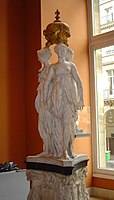
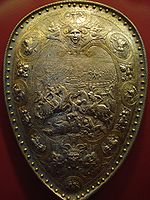



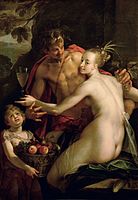
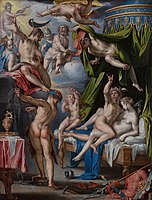
![Hans von Aachen, Allegory of Peace and the Arts, 1602.[19]](http://upload.wikimedia.org/wikipedia/commons/thumb/c/cb/Allegorie_des_Friedens_und_des_%C3%9Cberflusses_by_Hans_von_Aachen_001.jpg/149px-Allegorie_des_Friedens_und_des_%C3%9Cberflusses_by_Hans_von_Aachen_001.jpg)


